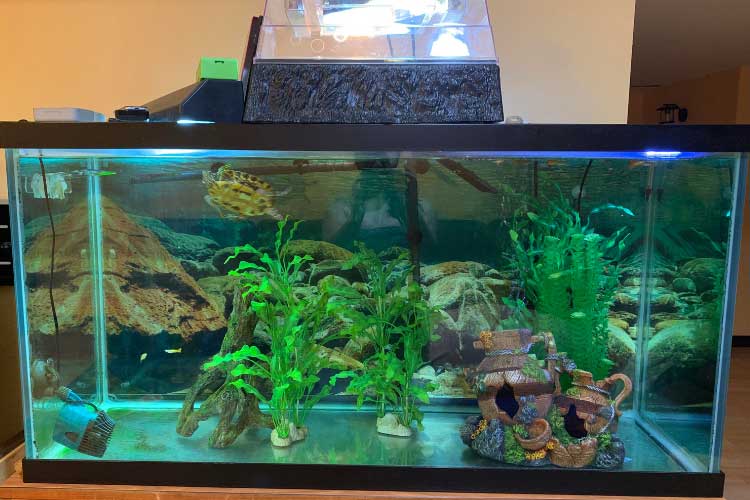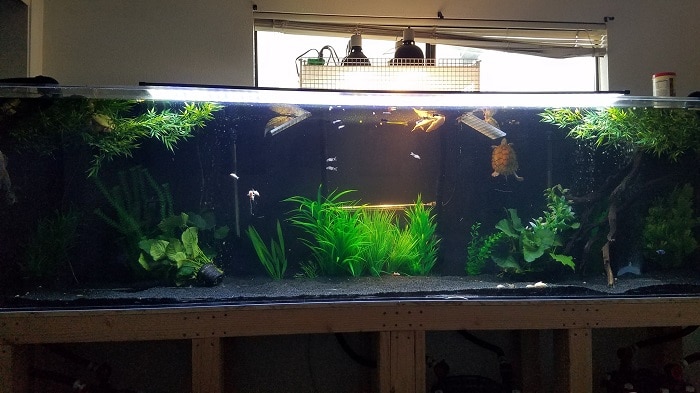Ideal tank decorations and hiding spots for red-eared slider turtles include basking docks, caves, plants, and rocks. These create a stimulating and secure environment while promoting their natural behaviors.
Red-eared slider turtles, native to north america, require an aquatic habitat with proper basking areas, such as floating docks or platforms, where they can rest and receive uv light. Additionally, caves or hollow logs provide hiding spots and create a sense of security for these semi-aquatic turtles.
Live or artificial plants and rocks offer places for exploration, nesting, and perching. By incorporating these elements into their tank, owners can ensure a stimulating and secure environment that accommodates the natural needs of red-eared slider turtles.

Credit: reptilehere.com
Understanding The Importance Of Tank Decorations And Hiding Spots
Tank decorations and hiding spots are essential for red-eared slider turtles to thrive. By creating a stimulating and secure environment, these turtles can enhance their overall well-being. Providing a variety of decor elements such as rocks, plants, and logs allows them to engage in natural behaviors like climbing and exploring.
Hiding spots like caves or tunnels offer a sense of security and privacy, reducing stress levels for these turtles. Remember to place these decorations strategically, ensuring they don’t obstruct swimming or basking areas. Additionally, make sure all decorations are safe, non-toxic, and easy to clean.
A well-decorated tank not only provides physical stimulation but also mental enrichment for your red-eared slider turtle. This promotes their mental and physical health, leading to a happy and thriving aquatic pet.
Creating A Natural Environment For Red-Eared Slider Turtles
Creating a natural environment for red-eared slider turtles involves incorporating live plants and vegetation in the tank. Adding live plants not only enhances the aesthetic appeal of the tank but also provides a sense of security for the turtles. The plants should be selected carefully, ensuring they are safe and non-toxic for the turtles to prevent any harm.
Additionally, incorporating rocks and driftwood in the tank can simulate their natural habitat, creating hiding spots and caves for the turtles to explore and rest. It is important to arrange these decorations strategically, ensuring that the turtles have enough space to swim and move around freely.
By recreating a stimulating and secure environment in their tank, red-eared slider turtles can thrive and lead a happy and healthy life.
Ideal Substrate Options For Red-Eared Slider Turtles
Red-eared slider turtles require ideal tank decorations and hiding spots to create a stimulating and secure environment. One important aspect to consider is the substrate for the tank. Gravel, sand, or a combination can be used as options. Each substrate type has its own benefits and considerations to take into account.
Gravel provides a sturdy surface for turtles to walk on, while sand mimics their natural habitat. However, gravel may cause issues if ingested and sand can be difficult to clean. A combination of both can offer the best of both worlds, providing a varied texture for the turtles.
When choosing the substrate, it is important to consider the specific needs and preferences of your red-eared slider turtle to ensure their well-being in their tank.
Providing Hiding Spots For Red-Eared Slider Turtles
Red-eared slider turtles require ideal tank decorations and hiding spots to create a stimulating and secure environment. One effective way to provide hiding spots is by using caves and tunnels, mimicking natural habitats. Adding artificial hideaways also allows them to retreat to a safe space.
These areas give the turtles a sense of security and minimize stress. By carefully selecting and arranging decorations, such as rocks, logs, and plants, you can create an appealing and stimulating environment for your red-eared slider turtles. A well-adorned tank not only enhances their well-being but also makes for a visually pleasing display.
Consider the turtles’ needs and preferences when choosing the decorations and ensure they have plenty of places to hide and explore.
Conclusion
To ensure a stimulating and secure environment for your red-eared slider turtles, it is crucial to carefully choose appropriate tank decorations and hiding spots. By following these guidelines, you can create an ideal habitat for your aquatic friends. First, opt for non-toxic materials to avoid any harm to the turtles.
Natural elements such as rocks, driftwood, and live plants not only provide hiding spots but also enhance the tank’s aesthetic appeal. Secondly, arrange the decorations strategically to create different levels and hiding places for your turtles to explore. This will encourage natural behaviors and keep them engaged.
You can also consider adding floating docks to provide a basking area where the turtles can rest and regulate their body temperature. Lastly, regularly monitor and clean the decorations to maintain a hygienic and healthy environment for your turtles. By implementing these recommendations, you can ensure your red-eared slider turtles thrive in their tank.
Happy turtle-keeping!





Leave a Reply